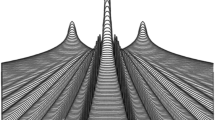Abstract
The deBroglie–Bohm quantum potential is the potential energy function of the wave field. The quantum potential facilitates the transference of energy from wave field to particle and back again which accounts for energy conservation in isolated quantum systems. Factors affecting energy exchanges and the form of the quantum potential are discussed together with the related issues of the absence of a source term for the wave field and the lack of a classical back reaction.
Similar content being viewed by others
References
Abolhasani, M., & Golshani, M. (1999). Born’s principle, action-reaction problem, and arrow of time. Foundations of Physics Letters, 12, 299–306.
Anandan, J., & Brown H. R. (1995). On the reality of space-time geometry and the wavefunction. Foundations of Physics, 25, 349–360.
Baggott, J. (1992). The meaning of quantum theory. Oxford: Oxford University Press.
Bohm, D. (1952). A suggested interpretation of the quantum theory in terms of “Hidden” variables.’ I & II. Physical Review 85:166–79 and 180–193.
Bohm, D. (1953). A discussion of certain remarks by Einstein on Born’s probability interpretation of the ψ-Function, in Scientific Papers Presented to Max Born, Oliver & Boyd, Edinburgh and London.
Bohm, D. (1957). Causality and chance in modern physics. London: Routledge & Kegan Paul.
Bohm, D., & Hiley B. J. (1987). An ontological basis for the quantum theory I. Physics Reports, 144, 323–348.
Bohm, D., & Hiley, B. J. (1993). The undivided universe: An ontological interpretation of quantum theory. London and New York: Routledge.
Close, F. (2004). Particle physics: A very short introduction. Oxford: Oxford University Press.
Cushing, J. T. (1994). Quantum mechanics: Historical contingency and the copenhagen hegemony. Chicago: Chicago University Press.
Cushing, J. T. (1998). Philosophical concepts in physics. Cambridge: Cambridge University Press.
Cushing J. T., Fine, A., & Goldstein, S. (eds) (1996). Bohmian mechanics and quantum theory: An appraisal. Dordrecht: Kluwer.
de Broglie, L. (1924). A tentative theory of light quanta. The London, Edinburgh and Dublin Philosophical Magazine and Journal of Science, 47, 446–458.
Dewdney, C., & Hiley, B. J. (1982). A quantum potential description of one-dimensional time-dependent scattering from square barriers and square wells. Foundations of Physics, 12, 27–48.
Doughty, N. A. (1990). Lagrangian interaction: An introduction to relativistic symmetry in electrodynamics and gravitation. Sydney: Addison-Wesley.
Fowles, G. R. (1977). Analytical mechanics. NY: Holt, Rinehart and Winston.
Freistadt, H. (1957). The causal formulation of the quantum mechanics of particles. Supplemento Nuovo Cimento, V, 1–70.
Garashchuk, S., & Rassolov, V. A. (2003). Quantum dynamics with bohmian trajectories: Energy conserving approximation to the quantum potential. Chemical Physics Letters, 376, 358–363.
Garashchuk, S., & Rassolov, V. A. (2004). Energy conserving approximations to the quantum potential: Dynamics with linearized quantum force. Journal of Chemical Physics, 120, 1181–1190.
Goldstein, H. (1980). Classical mechanics. M.A.: Addison-Wesley, Reading.
Grubin, H. L., Kreskovsky, J. P., Govindan, T. R., & Ferry, D. K. (1994). Uses of the quantum potential in modelling hot-carrier semiconductor devices. Semiconductor Science and Technology, 9, 855–858.
Guarini, M. (2003). Bohm’s metaphors, causality, and the quantum potential. Erkenntnis, 59, 77–95.
Holland, P. R. (1993). The quantum theory of motion: An account of the deBroglie–Bohm causal interpretation of quantum mechanics. Cambridge: Cambridge University Press.
Jackson, J. D. (1975). Classical Electrodynamics. New York: Wiley.
Jammer, M. (1966). The conceptual development of quantum mechanics. New York: McGraw-Hill.
Johnk, C. T. A. (1975). Engineering electromagnetic fields and waves. New York: Wiley.
Misner, C. W., Thorne, K. S., & Wheeler, J. A. (1973). Gravitation. Freeman: San Francisco.
Parmenter, R. H., & DiRienzo, A. L. (2004). Reappraisal of the causal interpretation of quantum mechanics and of the quantum potential concept. eprint arXiv:quantum-0305183 (22 May 2004).
Petersen, A. (1963). The philosophy of Niels Bohr. The Bulletin of the Atomic Scientists, 19, 8–14.
Riggs, P. J. (1999). Quantum phenomena in terms of energy-momentum transfer. Journal of Physics A: Mathematical and General, 32, 3069–3074.
Rindler, W. (1977). Essential relativity: Special, general, and cosmological. Berlin: Springer.
Rindler, W. (1982). Introduction to special relativity. Oxford: Pergamon.
Sefton, I. (2002). ‘Understanding electricity and circuits: What the text books don’t tell you’ in Proceedings of the 9th Science Teachers Workshop (Science Foundation for Physics, Sydney). Also available at: http://science.uniserve.edu.au/school/curric/stage6/phys/stw2002/sefton.pdf.
Smart, J. J. C. (1968). Between science and philosophy: An introduction to philosophy of science. New York: Random House.
Squires, E. J. (1994). Some comments on the de Broglie-Bohm picture by an admiring spectator. In A. van der Merwe & A. Garuccio (Eds.), Waves and particles in light and matter. New York and London: Plenum Press.
Veltman, M. J. G. (2003). Facts and mysteries in elementary particle physics. New Jersey: World Scientific.
Weyl, H. (1952). Space-time-matter. New York: Dover.
Woit, P. (2006). Not even wrong: The failure of string theory and the continuing challenge to unify the laws of physics. London: Jonathon Cape.
Author information
Authors and Affiliations
Corresponding author
Rights and permissions
About this article
Cite this article
Riggs, P.J. Reflections on the deBroglie–Bohm Quantum Potential. Erkenn 68, 21–39 (2008). https://doi.org/10.1007/s10670-007-9054-1
Received:
Accepted:
Published:
Issue Date:
DOI: https://doi.org/10.1007/s10670-007-9054-1




